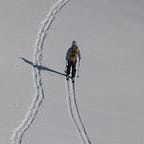Devil is in the details — Engineers will drive a motorbike through the loophole that the IMBA just opened
The International Mountain Bicycling Association (arguably the most important advocacy group for mountain biking) just changed their position on e-mountain bikes. At a high level, it makes sense but they’ve opened a loophole that they should fix as quickly as possible.
The IMBA is now supportive of “Class 1” eMTB access to non-motorized trails subject to certain conditions:
IMBA is supportive of Class 1 eMTB access to non-motorized trails when the responsible land management agency, in consultation with local mountain bikers, deem such eMTB access is appropriate and will not cause any loss of access to non-motorized bikes. IMBA recognizes that changes in design, technology and the numbers of eMTB users is evolving, and believes these bikes can be managed in a sustainable way for both the environment and other trail users.
At first, that sounds fairly reasonable. However, it doesn’t take long to see the main problem.
The definition of a Class 1 electric bicycle
Further down in their post, they define a Class 1 electric bicycle:
A Class 1 electric bicycle, or “low-speed pedal-assisted electric bicycle,” is defined as a bicycle equipped with a motor that provides assistance only when the rider is pedaling, and that ceases to provide assistance when the bicycle reaches the speed of 20 miles per hour.
On their main eMTB page, they expand that definition to note that: “ An electric bicycle is defined as a “bicycle equipped with fully operable pedals and an electric motor of less than 750 watts.” Interestingly enough, they provide that section in quotes but do not indicate where it is quoted from. One possible source is the California Vehicle Code. It’s worth noting that other jurisdictions have similar (but meaningfully different) definitions for the first tier of e-bikes.
This definition of a Class 1 e-bike was put together with careful thought by regulators that needed to decide what limits to place on e-bikes for use in urban areas. They were trying to answer questions such as: Can e-bikes use paved bike lanes and do they need vehicle insurance? The definition is appropriate in that context.
On the other hand, it is completely inadequate in the context of e-mountain biking. When the IMBA decide to relax their stance on eMTBs, they skipped the important step of forming a technical committee to come up with an appropriate definition.
The IMBA should retract their support for eMTBs until they create a definition that is appropriate for use on shared trails:
Torque: If you can do a burn-out, you are going to damage the trail. Their current Class 1 definition places no limit on torque.
Power: 750 Watts is way too much for this use-case and opens the door to motors that do a lot more than just “assist” the rider. Consider that:
“A pro climber like Giant-Alpecin’s Laurens ten Dam (the current holder of the Mont Ventoux KOM on Strava) will probably average about 400 watts on the final climbing section of Stage 12. The average rider would be closer to 195”
Power-assist-level: If you are putting in 1% of the energy and receiving a 99% assist, you are riding a motorbike. The current definition places no limit on the fractional power output of the motor assist.
Weight: If your bike weighs 90 lbs, you are also going to put excessive wear and tear on the trail. The current definition places no limit on weight.
Battery capacity: Closely related to the above point, with no limit on battery size, e-mountain bikes can be designed to carry very heavy loads and/or travel excessive distances. Picture a keg party with a sound system showing up at your local backcountry bike-packing location or increased visitors putting stress on Grizzly Bear populations in locations that used to be considered very remote.
With this endorsement from the IMBA, there is no doubt that designers at all of the major bike companies are now back at the drawing board with the “Class 1” definition as their only design constraint for a new generation of e-mountain bikes. The first generation of e-mountain bikes should not be used as a guide for what may follow in the coming years. For example, many of the e-mountain bikes today are only 250 Watts which is just 33% of what the IMBA is suggesting should be allowed on non-motorized trails in the future.
The IMBA should retract their new position statement immediately and take more time to put together proper definition for a “Class 1 eMTB”.
Cheers,
Steve
stevejoneshikes@gmail.com (I also bike and ski and climb — don’t write me hate mail)
